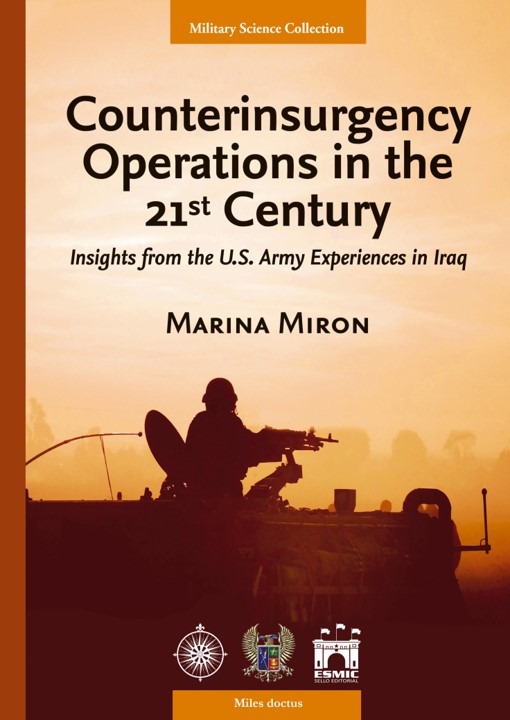
Counterinsurgency operations in the 21st century
Insights from the U.S. army experiences in Iraq
| Autor: | Miron, Marina |
| Colaboradores: | Monroy-Pinzón, Milton Fernando (Prologuista) Urriago Gutiérrez, Rubén (Diseñador) |
Materia:355.4 - Operaciones militares
Clasificación Thema::JWA - Teoría de la guerra y ciencia militar
JWL - Operaciones militares
Público objetivo:Profesional / académico
Colección:Ciencias Militares
Disponibilidad:Disponible
Estatus en catálogo:Activo
Publicado:2019-09-24
Número de edición:1
Soporte:Digital
Formato:Pdf (.pdf)
Idioma:Inglés
Libros relacionados
Pedagogía, Derechos Humanos y Derecho Internacional Humanitario: reflexiones sobre la enseñanza de estas disciplinas - Acuña Montañez, Nieves María; Lucero Rojas, Juan Carlos; Rodríguez Ortegón, Dahiana Mercedes; Romero Pérez, Xiomara Lorena; Prieto Fetiva, Camilo Humberto
Logística humanitaria y derechos económicos, sociales, culturales y ambientales en el Ejército Nacional de Colombia - Florián Velásquez, Gonzalo; Aristizábal Murillo, Juan Carlos; Rueda Navarro, Andrés Fabian; Henao Fonseca, Carlos Alberto; Machado Carrillo, José Francisco; Cuevas Silva, Juan María; Montes Ospina, Juan Alberto; Monroy Franco, Milton Fernando; Bermúdez Tapia, Manuel Alexis; Castro Aldana, Edwin Alberto; Forero Ortiz, Hugo Armando
Logística humanitaria y derechos económicos, sociales, culturales y ambientales en el Ejército Nacional de Colombia - Florián Velásquez, Gonzalo; Aristizábal Murillo, Juan Carlos; Rueda Navarro, Andrés Fabian; Henao Fonseca, Carlos Alberto; Machado Carrillo, José Francisco; Cuevas Silva, Juan María; Montes Ospina, Juan Alberto; Monroy Franco, Milton Fernando; Bermúdez Tapia, Manuel Alexis; Castro Aldana, Edwin Alberto; Forero Ortiz, Hugo Armando
Ataques indiscriminados y ataques desproporcionados de las FARC-EP - Clavijo Riveros, Faiber Eduardo; Cortés Castillo, Darío Enrique; Gamboa Flórez, Javier Hernán; Soler Parra, Carlos Javier; Guerrero Grimaldo, Juan Camilo; Castaño Rodríguez, Juan Carlos; Soto Gaviria, Andrés Felipe
Reseña
Too often states have faced internal threats from violent non-state actors seeking to overthrow the government and replace it with their own. Too often have states’ efforts fallen short in overcoming such an internal menace. This begs the question: is successful counterinsurgency possible? This question took the centre stage in light of the United States’ involvement in Afghanistan (2001) and Iraq (2003). Quickly it became evident that superior military strength did not translate into military success. The American way of war could not mitigate the escalating situation on the ground. The descent into chaos in Iraq has perpetuated the need for a new approach to counter the insurgents. This approach came to be known as “population-centric” counterinsurgency. By 2006, it appeared in the form of the US Army/Marine Corps joint publication entitled Field Manual 3-24 Counterinsurgency. The new manual offered an arguably new way of addressing insurgencies, shifting the focus from the enemy to the key population. For the US Army and Marine Corps, this ‘new’ thinking presented a radical departure from previous practices. However, was the initial success in Iraq, indeed, indebted to the implementation of the manual? And how ‘new’ was this new approach the manual laid out? In this book, the author closely examines the situation in Iraq and assesses in how far the new manual could be said to have contributed to the reduction of violence in Iraq in 2007. In addition, the core elements are examined in detail and contrasted with previous manuals in order to highlight that the ‘new’ thinking might not have been that new after all.




